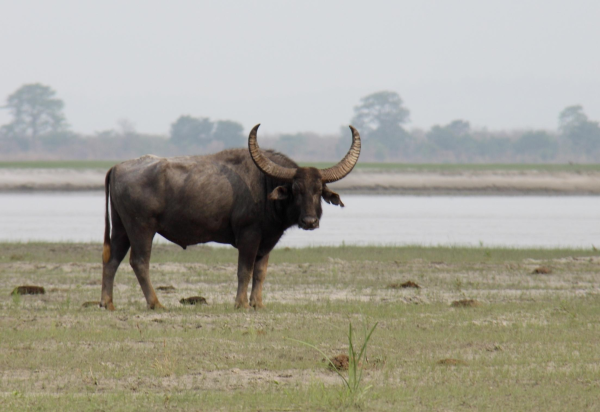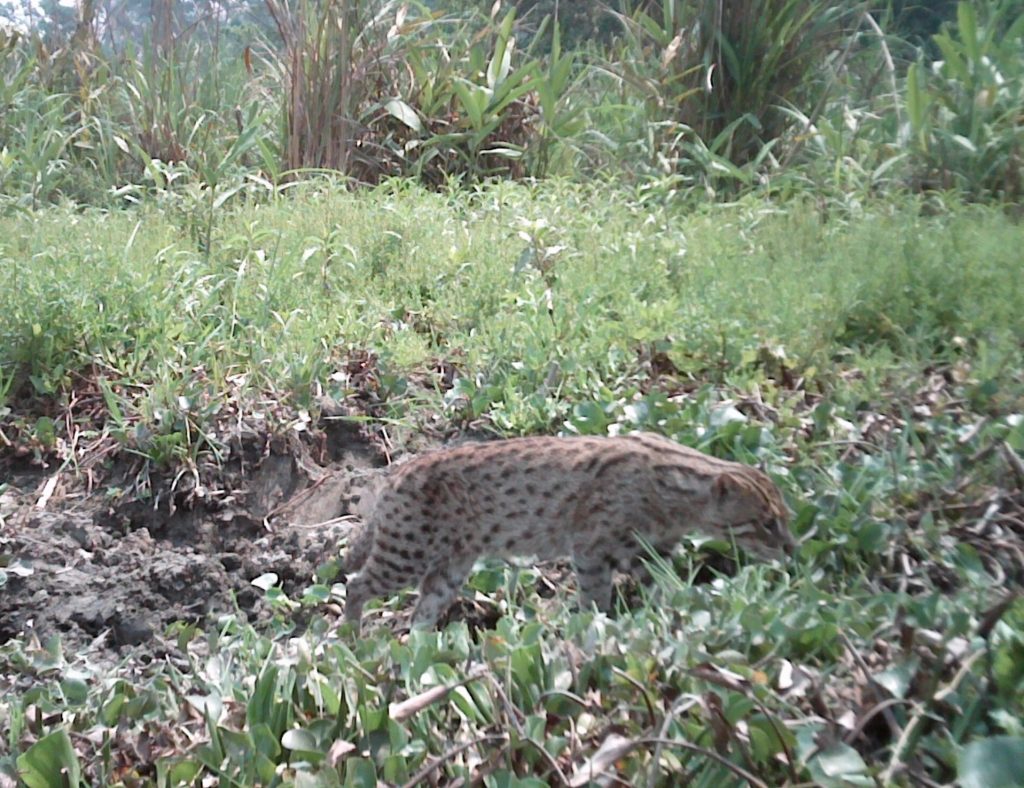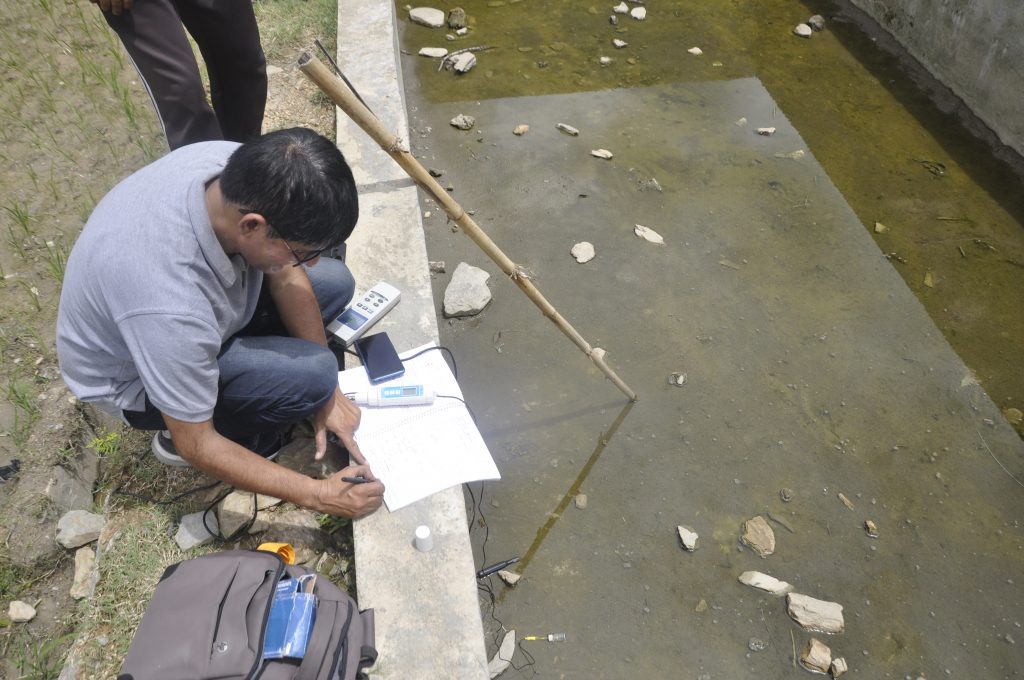FOOD HABIT AND CONSERVATION THREATS OF WILD WATER BUFFALO
- Nature Khabar

Santoshi Regmi*, Dr. Mukesh Kumar Chalise#
* Central Department of Zoology, Tribhuvan University, Kritipur Kathmandu, emai:. regmisanto@gmail.com
# Central Department of Zoology, Tribhuvan University, Kritipur Kathmandu, email: mukesh57@hotmail.com
ABSTRACT
The study "Food habit and conservation threats of wild water buffalo in Koshi Tappu Wildlife Reserve" was carried out aiming to explore feeding behaviors and conservation threats. The study was carried on "March and April 2016", for this research direct observation (Scan Sampling) and quadrate method was used to explore feeding behavior and food items of wild water buffalo. During the study it was recorded that Wild Water Buffalo spent more than 55% of diurnal time in grazing, 29% in rest and 12% of the time in wallowing. There is no significant difference in food items present in two study area (Madhuban and Kusaha). Similarly, there is no significant difference in the food items consumed by Wild Water Buffalo. The study shows that there is significant difference in food item present in open land (grazing) and forest area (rarely-grazing), hence Wild Water Buffalo prefer to graze on open land near the bank of river. Questionnaire survey was also carried out to know the different types of conservation threats of wild water buffalo. According to questionnaire survey almost all local people were positive for conservation of Wild Water Buffalo. But the study reveals that there is conservation threats like interspecies competition for food items, interbreeding with domestic and feral cattle etc. Different constructional works near the habitat of Wild Water Buffalo are also the threats. From questionnaire survey the major threats were recorded among these threats, hunting was found to be 20%, competition for food 33%, interbreeding 18%, habitat degradation 13%,natural calamities 11% and diseases was found to be 5%.
Key words:- Koshi Tappu Wildlife Reserve, Food habit, Conservation threats
INTRODUCTION
The wild water buffalo (Bubalus arnee) is a large bovine native to the Indian subcontinent and southeast Asia. It is also called as Asian buffalo, Asiatic buffalo and Wild Asian Buffalo. It has been listed as Endangered in the IUCN Red List since 1986. A population decline of at least 50% over the last three generations (24–30 years) is projected to continue (Hedges et al., 2008). The global population has been estimated at 3,400 individuals, of which 3,100 (91%) live in India, mostly in Assam (Choudhury, 2010).
In Nepal Wild Water Buffalo are found only in Koshi Tappu Wildlife Reserve, and had population of 63 individuals in 1976 which had grown to 219 individuals in 2009 (Heinen, 1993). According to the census 2016 the population has now grown considerably which has reached a total of 432 individuals with 120 males, 182 females and 130 calves, since there are no any natural predators like leopard, tiger or dholes in the reserve. The annual population growth rate of wild buffalo is quite more here at over seven percent. The authorities are taking into consideration for a possible translocation of some individuals to the floodplains of Chitwan National Park with a surge in the population, in order to expand their numbers at other sites within Nepal (NTNC, 2016).
Bubalus bubalis are ruminant which graze on grasses and sometime feed on herbs, aquatic plants, agricultural crops and various vegetations that are found near to the rivers and streams (Shackleton and Harestad, 2003).
Water buffalo frequently graze at the time of the morning and evening. During hotter parts of the day, they rest in patches of dense cover, wallow in mud holes, or completely submerge themselves in water with only their nostrils and eyes exposed. When deprived of wallowing grounds, water buffalo often seek shade to alleviate the stress of heat (Gurung and Singh, 1996; Macdonald, 2001).
Food and Feeding Behavior
"The wild water buffalo live mainly to level ground and is generally found in area of land, usually fairly large, that is always wet and is overgrown with various shrubs and trees. They like and often visit the densest and highest grass-jungle or reeds (tall slender plant with jointed stalks that grows in marshes and other wet areas). They are also found some times amongst low bushes and in open plains of short grass, but very hardly ever in tree-forest. They are associated in herds of large size. In the evening, at night, and in the morning (probably morning and evening as a rule) they feed chiefly on grass, and lie down, usually in high grass, not infrequently in a marsh, during the day. They appear to avoid the neighborhood of man, and they commit great damage amongst growing crops. They enjoy in water, and regularly throughout the heat of the day they lie down in shallow places with only parts of their heads above the surface (Ligda, 1999).
Conservation Status and threats
Wild water buffalo are legally protected in Bhutan, Nepal, India, and Thailand on nature reserves, and are listed in CITES under Appendix III (Nepal). Conservation programs are focusing on preserving their habitat, which is becoming increasingly difficult as human populations expand (Choudhury, 1994). The invasive Mikania sp. also potentially threatens wetlands in the South Asian range of wild Water Buffaloes (Baral, 2008).
Loss of habitat to humans and their livestock is one of the most important reasons for the specie’s decline in Nepal and there is now only one sub-population in the country (Massicot 2004; Roth 2004). The subpopulation in Koshi Tappu Wildlife Reserve but its habitat is under threats there too. The area is too small to encompass the full annual home range of any buffalo herd and wild buffalo which move out of the reserve come into conflict with local people. The area is also prone to flooding which leads to high calf mortality and flooding is expected to become an increasingly severe problem as a result of hydro-development schemes in the surrounding area (Aryal, 2011)
Conservation Actions
In order to reduce crop depredation by wild animals, a solar powered electric fence has been erected in the high impact zone of the eastern sector of the KTWR. This initiative has significantly reduced the existing local discord among the local communities and the reserve management. Similarly, with the erection of the electric fence, no reports of crop depredation have been reported in that area particularly by wild buffaloes and elephants. Similarly, sustained management interventions including a community based anti-poaching drive by mobilizing local youths, buffer zone communities, local teachers and eco-clubs has brought a positive impact towards the evacuation of feral cattle (cows and buffaloes) from the reserve. The reserve management with the active support of local communities has been able to collect a total of NPR 670140 from the penalties by confiscating cattle (both buffaloes and cows) from the Reserve and has collected total revenue of NPR 2933579.25 (KTWR, 2016).
MATERIALS AND METHODS
Study Area
Koshi Tappu Wildlife Reserve (26˚39ʹ N 87˚0ʹ, 175 sq. km.) is a protected area in the Terai of Eastern Nepal (Sunsari, Saptari and Udaypur districts). It was established in 1976 and designated as Ramsar site in December 1987. Koshi Tappu Wildlife Reserve lies in between two floodplain of the Sapta Koshi River which is subjected to annual flooding. Reserve comprises grassland (70%) followed by water and riverine forests (Peet et al., 1999). It ranges in altitude from 75 -81m (Shah, 1997). Reserve experiences three distinct seasons: Summer (February through May) is intensely hot with minimum precipitation, Monsoon (Late May/early June through September) with heavy and frequent rainfalls and winter (October through January) with clear skies and moderate temperature but can still get quite cold.
Koshi Tappu is a 16.3 Km long section of the Sapta Koshi River and its floodplain and the lowest southern boundary is about 9.3 km upstream of the Koshi Barrage. This dam was constructed to hold water during monsoonal floods which has been broken down by flood (3rd week of August 2008). The river is very wide and shallow. The water flow fluctuates and the water depth is variable up to 5 m. The soil is sandy to silty loam. The climate is subtropical (Karki, 2008).
Methods
The preliminary survey was carried out from 8th March to 11th of March 2016 in order to identify the habitat of the Wild Water Buffalo in the KTWR before commencement of the field work. During the field work the information were collected through the discussion with the park authorities, park personals of the KTWR and local people. The real field study was started from 15th March to 11th of April 2016.
Population count of studied herd
During the study period population count of Wild Water Buffalo was carried out in the KTWR. The population of wild water buffalo was counted on the basis of direct observation by the help of binocular of 12×50 and camera of 32X for the confirmation of number of wild water buffalo in the study area, same herd were observed everyday during the field study. Population count was made when Wild Water Buffalo were out at the bank of river for grazing in the studied area.
Feeding and behavioral observation
During research time they were found active in grazing in the morning and evening so observation was based on fresh plants being eaten, crushed tissue, fresh clipping etc. The freshly eaten plant species frequencies were recorded for vegetation sampling.
Scan sampling
The scan sampling was carried out for about 190 hours. The behavioral record was done for about 9-10 hours a day (7-8 AM to 5-6PM). Several types of instantaneous behaviors such as aggression, running, breast feeding in female herd, chasing etc and state behaviors such as wallowing, inactive, locomotion, forage etc were recorded . The activity of the herd at the time of scan was recorded. The plant species consumed by the Wild Water Buffalo were observed and noted, for this purpose Binoculars, hand plucking, quadrate sampling were used. Sometimes video recording of the activities was also carried out.
Wild Water Buffalo were observed at the interval of 1 minute for an individual and for group (number 4 to 6) the time interval was 10 to 15 minutes.
Vegetation sampling
For vegetation sampling quadrate method was used as main method. Quadrate of 20×20 meter was used for the recoding of smaller vegetations and 64×64 meter was taken in forest area for the record of bigger trees as well in different parts of study area.
Some of the plant species which were not recognized spontaneously were snapped, hand plucked and collected, later on remnants of the plants species were identified with the help of local people, guide and experts.
Data analysis
To carry out questionnaire survey number of questions were prepared and were interviewed with the local people.
Chi-square was used to test whether there is significant difference between the food item consumed by wild water buffalo in open grass land (grazing land) and in forest area (rarely grazing land) or not. Similarly to know the significant difference between food items consumed by Wild Water Buffalo in two different area. Chi-Square test was used for statistical test, P<0.05 was considered for significant result.
For the study following different materials were used:
Binocular, Digital camera of 32x zoom, Measuring tape, G.P.S., Stationeries, Scientific calculator etc.
Result and Discussion
According to this research the time spent by Wild Water Buffalo for different activities was found to be as followed.
| Activity | Male Herd (Minute) | Female Herd (Minute) | Average | Percentage |
| Grazing | 2943.92 | 3165.12 | 3054.52 | 53.85% |
| Rest (Ground) | 1173.20 | 2057.44 | 1615.32 | 28.48% |
| Wallowing | 962.64 | 292.88 | 627.76 | 11.07% |
| Drinking | 186.48 | 154.00 | 170.24 | 3.00% |
| Others | 128.80 | 280.00 | 204.40 | 3.60% |
| Total | 5395.04 | 5949.44 | 5672.24 | 100% |
Plant diet composition showed that Wild Water Buffalo of Koshi Tappu Wildlife Reserve were highly herbivorous. They also fed on various parts of plants such as grasses, herbs and shrubs. There was no significant difference in the utilization of plant species found in two studied area. ( x2=0.56, df=2, p value< 0.05).
Wild Water Buffalo were found feeding naturally on various plant species. Crop raiding was not noticed during the study. There was no significant difference in the food items consumed by Wild Water Buffalo in two studied areas (Madhuban and Kusha) (x2=2.69, df=3, p< 0.05).
On grazing land and rarely grazing land 35 plant species were recorded among them 3 species of plants were trees, 6 shrubs, 8 herbs and 18 grasses. Wild Water Buffalo feed on 24 plant species. Among them 6 species were shrubs, 2 herbs and 16 grasses whereas they do not feed on tree species. They generally feed on tender and soft part of plant especially grazes recently germinated plants.
Competition with Feral and Domestic cattle
During the study period it was found that there is sharing of the food resources among the Wild Water Buffalo and other feral and domestic cattle. The table below illustrates the number of Animals recorded in grazing area.
| Animal Type | Study Area | |
| Near Madhuban | Near Kusaha | |
| Wild Water buffalo | 58 | 35 |
| Other cattle | 27 | 12 |
| Total | 85 | 47 |
| Percentage of Wild Water Buffalo | 62.23% | 74.46% |
| Percentage of other cattle | 31.76% | 25.57% |
Discussion
Wild Water Buffalo spend 50% of the time that is about 5 hours and 45 minutes of average diurnal time (11hours and 30 minute) for grazing. They were found mostly grazing near water sources and open ground which was covered with sampling of Thatch grass (Sacchrum spotaneum). The average density of the grass in the grazing field of the study area was found to 247 per square meter (Rai and Chalise, 2014).
This study showed that the Wild Water Buffalo spend 54% of diurnal time for grazing and usually they prefer to graze in morning and evening. They spend 29% of the time in rest they rest mostly during afternoon and they also wallow during afternoon spending about 11% their time. Among all other activities they spend most of the time for grazing and in foraging.
Wild Water Buffaloes feed on 25 plants species. The grasses (herbs monocot) Cymbopogan sp., Cynodon dactylon, Imperata cylindrica, Leptochola chinesis, Pharagmites sp., Saccharum spontaneum and Sporobolus dinder were the most preferred while Desmostachya coegyplica and Rotal diversifolia were the less preferred species. Among browse Dalbergia sissoo was most preferred while Acascia catechu and Bombax ceiba were less preferred species. Among the herbs dicot and others Saccharum officinarum were most preferred while Scoparia dulcis and Sida rhombifolia were less preferred plant species. The most preference plants were observed most frequently consumed by the animals. This is due to the abundance of these species in the foot hills of the intensive study area. (Chaudhary, 2001)
Wild Water Buffalo prefers to graze on the open grass land. During the study 35 different species of plants were recorded in the study area {Grazing (Open land) and rarely grazing (near Forest area)}. There is significant difference in plant species present in grazing and rarely grazing land. The most preferred plant species by Wild Water Buffalo are present in open grass land (bank of river) so the Wild Water Buffalos prefer to graze in open grassland and rarely graze near forest area.
Conservation threats
Wild Buffaloes are recorded in the agriculture fields. This may be due to competition between wild buffaloes and domestic cattle for food. It gives an indication that there is no enough food available inside the reserve. (Chaudhary, 2001)
Recently the reserve has provided facility of the solar fencing in the eastern part of the reserve hence competition for food was not observed, similarly no any Wild Water Buffalo were recorded coming out of the reserve for crop raiding.
Similarly due to lack of solar fencing in western part of KTWR, domestic cattle enter inside the reserve without any impasse either unknowingly or intentionally. This study revealed that major threats to Wild Water Buffalo is the presence of domestic cattle entered from western side and other feral cattle in their habitat due to which Wild Water Buffalo are forced to share their food items and pasture land along with their habitat which may lead to hybridization of wild water buffalo. The problem of inter breeding which hybridizes the Wild Water Buffalo that may lead to the annihilation of Pure Wild Water Buffalo. There is also maximum probability of spreading different types of diseases due to imminence with other cattle.
The feral cattle population is less and daily visitor domestic cattle are higher. Feral cattle population were minimum because the wildlife census is carried out soon after the feral cattle evacuation campaign but daily visitor population is higher because local people release their cattle inside the reserve for grazing and this is because of only one security post in western sector (Saptari) and area is large (Ram and Acharya, 2001).
But during this research there were no any domestic cattle of local people entered from eastern part (Study area) of the reserve.
Wild Water Buffaloes are probably the most seriously affected species by domestic cattle interference along with chital, hog deer and blue bulls Wild Water buffaloes usually avoid the area used by livestock for grazing (Chaudhary, 2001).
Other cattle also graze in the same area where Wild Water Buffalo graze; hence resource division is clearly noticed on study area. There is significant competition on food item between Wild Water Buffalo and other cattle (Feral Cattle) in the grazing area. According to this study there is no any competition of food in two study area (Madhuban and Kusaha) but there is competition within the same grazing land among other cattle and Wild Water Buffalo.
These data and graphs revels that local people are more positive for the conservation of Wild Water Buffalo in KTWR. Only few were neutral and none of them showed negative attitude for the conservation of Wild Water Buffalo.
Figure 1: Different threats of Wild Water Buffalo.
From the questionnaire survey the major threats of Wild Water Buffalo were recorded. The major threats include diseases, hunting, competition for food, Habitat degradation, Interbreeding, Natural calamities etc. On the basis of number of respondent for respective threats the above pie chart was prepared.
Status of Feral and domesticated animals in KTWR
The number of Wild Water Buffalo is increasing which indicates the increase in population density. The home range of Wild Water Buffalo is (home range 0.66 to 3.86 sq mile or 1.709 to 9.997 sq Kilometer) (Nowak, 1999).
Inspite of various threats the population of wild Water Buffalo is able to thrive in KTWR. The area and food availability in KTWR is insufficient to hold the increasing rate of Wild Water Buffalo so they need alternative habitat which is similar to KTWR. This is because the present population density of Wild Water Buffalo is 2.468 per square kilometer.
REFERENCES
Aryal, A., Shrestha, T.K., Ram, A., Frey, W., Groves, C., Hemmer, H., et.al. 2011. Call to conserve the Wild Water Buffalo (Bubalus arnee) in Nepal. International Journal of Conservation Science of conservation science, 2(4): 261-268.
Chaudhary, L.N. 2001. Status, distribution and feeding habit of Wild buffalo Bubalus bubalis arnae arne of Koshi Tappu Wildlife Reserve.
Choudhury, A. 2010. The decline of the wild water buffalo in north-east India. Oryx, 28: 70-73.
Cockrill, W. R. 1984. Water buffalo. In: Mason, I. L. (ed.), Evolution of Domesticated Animals, pp. 52-63. Longman, London
Gurung, K.K. and Singh, R. 1996. Field Guide to the Mammals of the Indian Subcontinent. Academic Press, San Diego, California, USA.
Heinen, J. 1993. Population viability and management recommendations for wild water buffalo Bubalus bubalis in Kosi Tappu Wildlife Reserve, Nepal. Biological Conservation, 65:29-34.
Karki, J.B. 2008. Koshi Tappu Ramsar Site: Updates on Ramsar Information Sheet on Wetlands Sheet on Wetlands https://www.nepjol.info/index.php/INIT/article/view/2513/2241 Accessed on 13 December 2016
"KTWR to shift 30 ‘Arnas’ to Chitwan". www.kathmandupost.ekantipur.com. Retrieved 5 April 2016.
Ligda, D. 1999. "Work" (On-line). Water Buffalo. Accessed January 31, 2004 at http://ww2.netnitco.net/users/djligda/waterbuf.htm.
Macdonald, D. 2001. Wild Cattle and Spiral-Horned Antelope. Pp. 530-539 in Gateman, T Allan, M Salad, eds. The New Encyclopedia of Mammals. New York: Oxford University Press.
Nowak, R. M. 1999. Walker's Mammals of the World. Volume 1. The Johns Hopkins University Press, Baltimore, USA and London, UK
NTNC. 2016. "Water Buffaloes increased to 432 individuals in Nepal". http://www.ntnc.org.np/news/water-buffaloes-increased-432-individuals-nepal. retrieved on 5 April 2016.
Peet, N., Watkinson, A.J., Bell, D.J. and Kattle, B.J. 1999. Plant Diversity in the threatened subtropical grassland of Nepal. Biological Conservation, 88:1
Rai, N.S. and Chalise, M. K. 2014. Diurnal Activities of Wild Water Buffalo (Bubalus arnee) in Koshi Tappu Wildlife Reserve, Eastern Nepal (A case study of Kusaha). 19th Wildlife week, Special Issues on Biod. Cons. Efforts in Nepal. DNPWC, Kathmandu, Nepal, pp. 104-112.
Ram, A. and Acharya, K.P 2001. Status, Distribution, Threat and Habitat pattern assessment of Asiatic Wild Water Buffalo in Koshi Tappu Wildlife Reserve, Eastern Nepal.
Shackleton, D., A. Harestad. 2003. Bovids I – Kudus, buffaloes, and bison. Pp. 11-25 in M Hutchins, D Kleiman, V Geist, M McDade, eds. Grzimek's Animal Life Encylopedia, Vol. 16, 2nd Edition. Farmington Hills, MI: Gale Group.
Shah, J.P. 1997. Koshi Tappu Wetlands: Nepal’s Ramsar Sites. IUCN Bangkok, Thailand.xviii+254pp.





Feedback